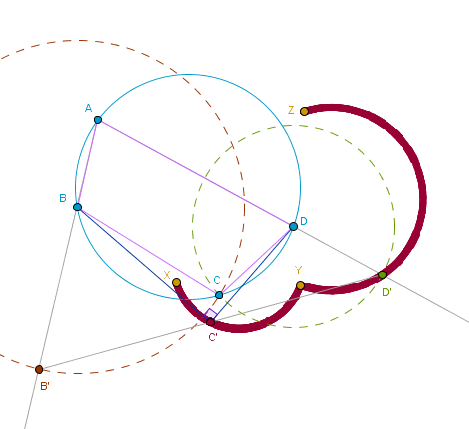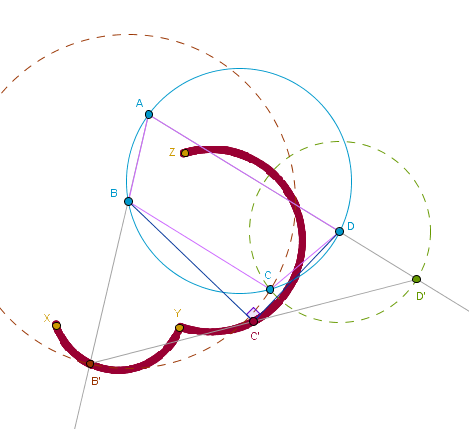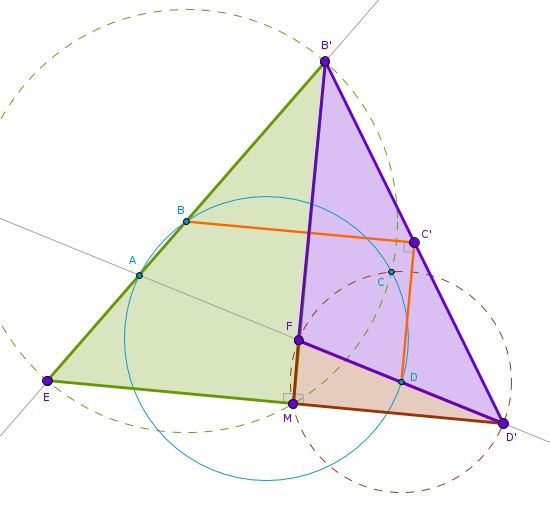 Author
Author |
Topic: Angles around the circle (Read 567 times) |
|
jollytall
Senior Riddler
   

Gender: 
Posts: 585
|
 |
Angles around the circle
« on: Jan 4th, 2015, 2:24pm » |
 Quote Quote  Modify Modify
|
There is a given ABCD quadrangle in a circle (A, B, C, D are on the perimeter. We extend AB after B and AD after D. On the AB we select B', so that BB'=BC and on AD we select D', so that DD'=DC. Now we take the middle point of the B'D' sector, called C'.
What is the BC'D angle?
|
|
 IP Logged IP Logged |
|
|
|
towr
wu::riddles Moderator
Uberpuzzler
    

Some people are average, some are just mean.
Gender: 
Posts: 13730
|
 |
Re: Angles around the circle
« Reply #1 on: Jan 4th, 2015, 6:54pm » |
 Quote Quote  Modify Modify
|
Neat, it's always 90 degrees.
But I haven't put more effort into it than playing around in cinderella, so no proof yet.
|
|
 IP Logged IP Logged |
Wikipedia, Google, Mathworld, Integer sequence DB
|
|
|
rloginunix
Uberpuzzler
    

Posts: 1029
|
 |
Re: Angles around the circle
« Reply #2 on: Jan 4th, 2015, 5:13pm » |
 Quote Quote  Modify Modify
|
Beautiful problem, jollytall, and long time no hear.
According to a sample Geogebra construction it must always be exactly ninety degrees.
Preliminary idea: prove it for squares first, then rectangles, then inscribed trapezoids and then for an arbitrary cyclic quadrilateral.
|
|
 IP Logged IP Logged |
|
|
|
rloginunix
Uberpuzzler
    

Posts: 1029
|
 |
Re: Angles around the circle
« Reply #3 on: Jan 6th, 2015, 9:32pm » |
 Quote Quote  Modify Modify
|
Found one solution.
It will take me a while to type it all in (hopefully by this weekend) but for now the key idea: the two circles used to obtain B' and D' intersect at two points. One point is obviously C, call the other one M. I proved that B'MD' is also exactly 90 degrees. From there the proof that BC'D is 90 degrees follows.
|
|
 IP Logged IP Logged |
|
|
|
jollytall
Senior Riddler
   

Gender: 
Posts: 585
|
 |
Re: Angles around the circle
« Reply #4 on: Jan 6th, 2015, 11:58pm » |
 Quote Quote  Modify Modify
|
Beautiful.
Let me try to write it down (though the solution is yours):
BAD+MB'B+MB'D'+MD'B'+MD'D=180 (triangle)
D'MB'+MD'B'+MB'D'=180 (triangle)
BAD+BB'M+DD'M=B'MD' (difference of the above two)
DMD'=DD'M and BMB'=BB'M (D and B are the middles of the two circles)
BAD+BMB'+DMD'=B'MD' (replacing in the above equation the last two)
BMD=BCD (symmetry)
BCD=180-BAD (inscribed quadriteral)
BMD=BMB'+B'MD'+DMD' (adding up three parts of the angle)
180-BAD=BMB'+B'MD'+DMD'
Adding up this and the one few lines above
180-BAD+BAD+BMB'+DMD'=BMB'+B'MD'+DMD'+B'MD'
180=2*B'MD'
90=B'MD' (this is your first statement)
From here we know MC'=B'C' (Thales)
Then MC'B'B is a deltoid, i.e. BC' is right angle to B'M (crossing in E).
Similarly DC' is also right angle to D'M (crossing in F).
So in the quadrangle of MEC'F three angles are 90, consequently the fourth is also.
|
|
 IP Logged IP Logged |
|
|
|
jollytall
Senior Riddler
   

Gender: 
Posts: 585
|
 |
Re: Angles around the circle
« Reply #5 on: Jan 7th, 2015, 12:03am » |
 Quote Quote  Modify Modify
|
FYI: My less successful prove tried to use vector algebra, having four vectors pointing from the middle of the circle to the four corners. From there both C' and the middle point of BD (call it G) can be expressed and the length of BD is twice as the length of the GC'.
It got into an ugly 10 page set of equation, but I got lost in it and was lazy to work it through...
|
|
 IP Logged IP Logged |
|
|
|
rloginunix
Uberpuzzler
    

Posts: 1029
|
 |
Re: Angles around the circle
« Reply #6 on: Jan 7th, 2015, 10:18am » |
 Quote Quote  Modify Modify
|
You got it. Thank you for typing it in.
After a few false starts I realized that if it's the current problem I can't solve then there exists a simpler problem I can't solve. Find it. Repeat. Until a problem can be solved, reverse the steps back to the original problem, etc. Hence, my earlier post.
One thing I would like to add. In GeoGebra you can manipulate a number of properties for points, straight lines, circles. One such property is called "Show Trace". If turned on for, say, a point then any movement of this "traced" point is recorded visually by GeoGebra in the form of (usually) some curve. So I decided to trace the point C'.
Look at what happens when we fix A, C, D but move B around:

The bottom left-most edge of the snowman, the point X, corresponds to the state when B == A and we approached A moving clockwise. If we stop here and move B away from A counterclockwise then the smaller part of the snowman is drawn. Its waist or the cusp, Y, (where I suspect there is no derivative) corresponds to the state when B == C.
As we keep moving B (still counterclockwise) towards D the larger part of the snowman is drawn. As we pass D and move towards A the snowman sweeps through D'. When B == A and we keep moving (counterclockwise) then the trace curve breaks at Z and C' jumps abruptly from Z to X.
If we fix A, B, C and move D around a similar shape emerges:

Not sure what is the meaning of this. May be SWF will come up with another awesome tessellation or explain it in 3-D with spheres, cubes and cylinders. I can just remark that in 2-D it is a linkage that transforms a circular motion into almost figure eight motion. Its parameters can be calibrated via choosing an appropriate shape of the cyclic quadrilateral.
[edit]
If only I could spell, "waste" became "waist".
[/edit]
|
| « Last Edit: Jan 7th, 2015, 10:39am by rloginunix » |
 IP Logged IP Logged |
|
|
|
rloginunix
Uberpuzzler
    

Posts: 1029
|
 |
Re: Angles around the circle
« Reply #7 on: Jan 13th, 2015, 7:59pm » |
 Quote Quote  Modify Modify
|
While searching for an inversion-based solution I came up with this small more symmetrical variant instead.
It is based on Euclid's B6.P2 - a parallel to a triangle's base cuts its sides in the same proportion and, conversely, if a line cuts triangle's sides in the same proportion then it is parallel to its base.
Here in triangle EB'D' B cuts EB' in half (construction) and C' cuts B'D' in half (given). Hence, BC' is parallel to ED'. In triangle FB'D' D cuts FD' in half (construction). Hence, DC' is parallel to MB':

But we already proved that the angle B'MD' is right. From B3.P31 (in a circle the angle in the semicircle is right) it follows that the angle B'ME = 90 degrees. Hence, the points E, M, D' are collinear, points B', F, M are collinear, points E, B', D' indeed form a triangle and the above B6.P2 idea holds.
|
|
 IP Logged IP Logged |
|
|
|
|
 WRITE MATH!
WRITE MATH!
 Home
Home  Help
Help  Search
Search  Members
Members  Login
Login  Register
Register WRITE MATH!
WRITE MATH!
 Home
Home  Help
Help  Search
Search  Members
Members  Login
Login  Register
Register